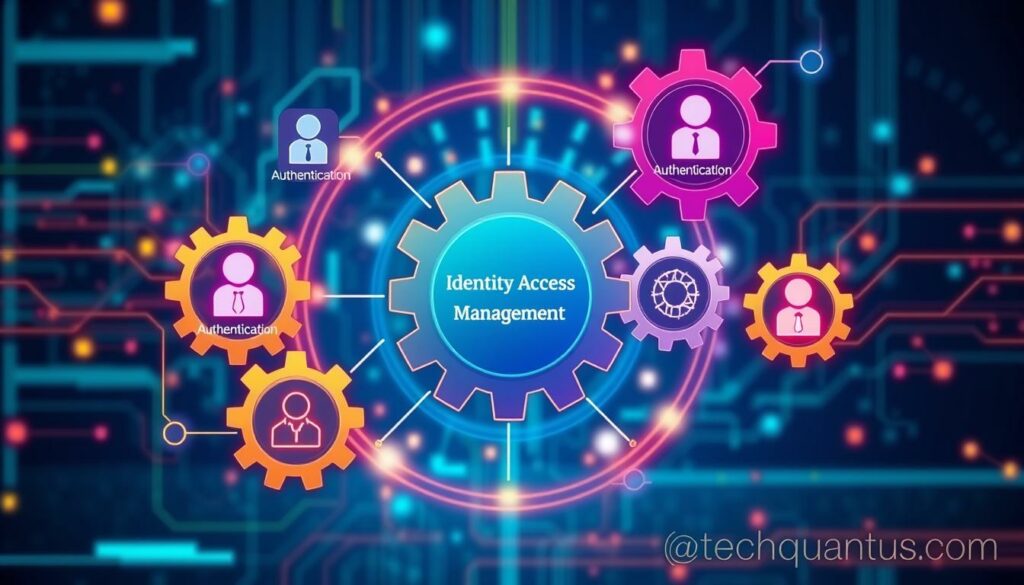In today’s digital world, knowing about IAM is key for businesses. IAM stands for Identity Access Management. It’s about controlling who gets to see or change important information in your company. It’s all about managing digital identities well.
Many things like cloud computing and on-premises solutions help with IAM. Learning about IAM basics helps keep your data safe. It also makes your company’s security better.
Key Takeaways
- Understanding IAM is crucial for controlling access to sensitive data.
- It encompasses various policies, processes, and technologies.
- Multiple channels like cloud and on-premises are integral to IAM.
- Effective IAM helps protect digital identities.
- A robust IAM strategy enhances overall security.
Understanding Identity Access Management (IAM)
Identity Access Management (IAM) is key for managing who can access what on different devices and apps. It’s vital in today’s world where cyber threats keep growing. Good IAM strategies make sure only the right people can see certain data and resources, making things safer.
IAM uses important technologies like Single Sign-On (SSO) and Multi-factor authentication. SSO lets users log in to many apps with just one set of credentials. This makes things easier for users while keeping things secure. Multi-factor authentication adds an extra step, making it harder for hackers to get in.
Role-based access control gives users the right to see only what they need to do their job. This limits who can see sensitive information. It’s all about keeping things safe and simple.
As companies deal with more data and rules, IAM becomes even more important. A good IAM overview helps things run smoothly and keeps businesses in line with the law. Without a solid IAM plan, companies might struggle with keeping things efficient and following rules.
For companies with old data, IAM tools like AWS Lake Formation and AWS IAM Identity Center are great. They help manage old data safely. These tools work with identity providers to keep data protected. They make sure only the right people can access what they need, keeping everything under control.
The Importance of IAM in Today’s Digital World
In today’s world, data breaches and cyber threats are common. IAM authentication and authorization are key. They help keep data safe and follow rules.
With more people working from home, IAM helps control who can access what. It’s about keeping information safe and making work easier. Companies need systems that work well with old data and give the right access to users.
Data is growing fast, and so is the need to keep it safe. Not doing this can cause big problems. IAM helps manage these issues. Tools like AWS Lake Formation and IAM Identity Center are good examples.
Good IAM management means keeping an eye on security. It’s important as roles change in companies. IAM helps build trust and accountability in a digital world. Learning about the Zero Trust Security model can help improve IAM strategies.
Using IAM wisely can lower risks of unauthorized access. This way, companies can handle their digital world with confidence.
Introduction of IAM: Key Definitions and Concepts
IAM covers important areas like identification, authentication, and authorization. These are key to keeping organizations safe. Knowing these terms is crucial for good IAM practices.
Identification checks who users are by verifying their personal details. This step is the first in building trust and security. Then, authentication confirms users have the right credentials, proving their identity.
Authorization decides what access users get based on who they are. By setting roles and permissions, companies control what users can do. This keeps sensitive info safe and helps authorized people get to what they need.
Also, auditing is a big part of IAM. It checks user activity to make sure policies and laws are followed. This helps spot security issues fast and checks if IAM plans are working well.
Components of an IAM Framework
Effective Identity and Access Management (IAM) is key for any organization to improve its security. Knowing the parts of an IAM framework helps in managing IAM better. This ensures strong protection against unauthorized access and breaches.
At the heart of an IAM framework are several important parts that work well together:
- Identity Repositories: These are central places for user info. They are key for accessing user details and attributes.
- Access Management Tools: These tools control what users can do. They decide who can see or use certain data and resources.
- Auditing Systems: These systems watch user actions. They make sure everything follows rules and policies.
- Disaster Recovery: This includes plans and tech for keeping business running when data is lost or stolen.
- Lifecycle Management: This handles a user’s identity from start to end. It includes creating, changing, and deleting identities.
These parts, when used right, make a strong IAM framework. This framework helps meet security needs both inside and outside the organization. For more on IAM and its frameworks, check out Zero Trust models for better IT security.

| Component | Description | Importance in IAM Management |
|---|---|---|
| Identity Repositories | Centralized storage for user credentials | Ensures accurate and secure access to identity data |
| Access Management Tools | Tools to manage permissions | Regulates data access to authorized users only |
| Auditing Systems | Monitor user activities | Helps in compliance and identifying security breaches |
| Disaster Recovery | Plans for data recovery | Maintains business operations during data loss |
| Lifecycle Management | Manage the entire identity lifecycle | Ensures that user access is current and secure |
Each part is vital for a strong IAM framework. This framework is key for protecting company assets in today’s digital world.
How IAM Works: Identification, Authentication, and Authorization
Understanding IAM means learning about three key steps: identification, authentication, and authorization. Each is vital for keeping access to resources safe in an organization.
First, identification is when users create their own profiles. This step is key for knowing who’s trying to get into systems. It’s the base for the IAM process.
Authentication then checks if the identity is real. You can use passwords, biometrics, or tokens for this. IAM authentication makes sure only real users get to sensitive data and systems. Without good authentication, IAM can be at risk of breaches.
Finally, authorization decides what a user can do and see. Good IAM authorization lets organizations follow the least privilege rule. Users only get to what they need for their job. This lowers the chance of unauthorized access and keeps sensitive info safe.
In short, these parts work together well. Without identification, there’s no one to check or give access to. When IAM authentication and authorization work right, they make a strong place for managing data. This is a big help for an organization’s security plan.
| Process | Description | Methods |
|---|---|---|
| Identification | Creating a unique user profile | Account creation forms, usernames |
| Authentication | Verifying user identity | Passwords, biometrics, hardware tokens |
| Authorization | Determining access levels | Role-based access control, policies |
IAM Technologies: What You Need to Know
As we move more into the digital world, knowing about IAM technologies is key. They help keep our systems safe and work smoothly. IAM technologies handle user access, making sure we can log in securely and easily.
Single Sign-On Systems
Single Sign-On (SSO) lets you get into many sites with just one login. It makes life easier for users and helps avoid password problems. With SSO, logging in is a breeze, which means we can work better and stay safer online.
Multi-Factor Authentication
Multi-Factor Authentication (MFA) adds an extra layer of security. It asks for more than just a password to confirm who you are. This could be something you know and something you have. MFA is a big help in keeping our systems safe from unauthorized access.
Privileged Access Management
Privileged Access Management (PAM) deals with users who have special access. These users can see or change important data. PAM makes sure only the right people can get to this sensitive stuff.
Want to know more about how these IAM technologies work with today’s digital tools? Check out Google’s generative AI ecosystem and its features.

| IAM Technology | Description | Benefits |
|---|---|---|
| Single Sign-On | Allows access to multiple services with one set of credentials. | Improved user convenience and reduced password fatigue. |
| Multi-Factor Authentication | Requires multiple verification methods to confirm user identity. | Enhanced security and reduced risk of unauthorized access. |
| Privileged Access Management | Controls access for users with elevated privileges. | Minimized risks associated with sensitive data and systems. |
The Benefits of Implementing IAM
Effective IAM systems bring many benefits to organizations. They improve security, make operations more efficient, and help with compliance. As data and rules change, knowing the IAM benefits helps you stay ahead. It ensures a strong management system.
Enhanced Security and Risk Mitigation
One key IAM benefit is better security. Automated access controls and constant checks help prevent data breaches. This way, organizations can control who accesses data, lowering the risk of leaks.
Using IAM tools like AWS IAM Identity Center helps manage access better. It aligns access with roles, keeping sensitive info safe.
Improved Operational Efficiency
IAM also boosts operational efficiency. It automates tasks like setting up and removing user accounts. This lets your team focus on important work, not manual tasks.
Good IAM practices save time and resources. They make workflows smoother, boosting productivity. Solutions like AWS Lake Formation help manage old data well, keeping systems current.
Regulatory Compliance
Meeting regulatory standards is crucial for businesses. IAM helps organizations follow strict rules, ensuring data access is monitored. This is key as rules get stricter, avoiding fines and protecting data.
IAM tools keep an eye on access controls. They help maintain compliance, keeping your organization safe.
Best Practices for IAM Management
Effective IAM management is key to keeping your organization safe and running smoothly. By following the best practices, you can boost your security, make processes easier, and lower risks. There are a few important strategies to focus on for strong IAM management.
Automating Access Control
Automating access control is a top IAM best practice. It cuts down on human mistakes, making your system more secure. Automation makes access decisions more accurate and updates permissions quickly when roles change or projects start.
Tools for automation can fit into your current systems, creating efficient workflows.
Regular Auditing and Monitoring
Regular checks on access controls are crucial for staying secure and following rules. It’s important to keep an eye on user permissions to make sure they match your security policies. Looking at access logs helps spot unauthorized access and weak spots.
Having a set schedule for audits helps stick to IAM policies and keeps your system safe.
User Training and Awareness
Teaching users about IAM is essential. Good training programs show employees why security matters, what they need to do, and how to spot threats. Regular training sessions keep best practices top of mind, making employees a big part of your security team.
For example, training might cover quantum encryption and its role in keeping data safe.
| Best Practices | Description |
|---|---|
| Automating Access Control | Reducing manual errors by implementing automated tools for access permissions management. |
| Regular Auditing and Monitoring | Conducting regular reviews of access controls and monitoring logs to enhance security. |
| User Training and Awareness | Providing employees with knowledge and training on security protocols and best practices. |
IAM Principles: Aligning with Business Goals
For IAM principles to work well, they must match your company’s goals. This link helps IAM support smooth operations and better security. As things change, updating your IAM plans is key to managing old and new data systems well.
Every company faces special challenges in handling old data, especially in strict industries. Not tackling these problems can lead to lost data, slow work, and legal issues. A strong IAM approach can help avoid these problems and make security a part of everyone’s job.
Using AWS tools makes IAM better by making data handling easier. For example, AWS Lake Formation and AWS IAM Identity Center help different roles get to important data without changing who can do what. Setting up AWS IAM Identity Center with a service like Microsoft Entra ID makes it easy to keep user and group info up to date.
- Creating special permission sets like Data-Engineer and Auditor helps control who can do what.
- Defining specific policies for certain groups makes things safer by limiting access.
- Setting up data pipelines is key for handling data during big changes.
With more data and stricter rules, companies must really get IAM and make it part of their plans. This connection makes your business run better and keeps it safe.
Challenges in IAM Implementation
Setting up effective IAM management is tough for companies, especially in strict industries. One big problem is handling old data from outdated systems when moving to new tech. This can lead to lost data, slow operations, and breaking rules if not fixed right.
With more rules and lots of data, companies need strong plans to deal with data issues. Using tools like AWS Lake Formation and AWS IAM Identity Center helps them face these problems. AWS Identity Center lets companies control access tightly, making it easy to work with outside identity providers like Microsoft Entra ID.
The table below shows some IAM challenges and how to solve them:
| Challenge | Potential Consequence | Solution |
|---|---|---|
| Legacy System Data Governance | Data loss, compliance violations | AWS Lake Formation integration |
| Data Volume Growth | Operational inefficiencies | Comprehensive data strategies |
| Regulatory Scrutiny | Increased compliance costs | Robust IAM concepts implementation |
To get IAM right, companies need strong leadership and clear talks about IAM’s benefits. Tackling IAM’s tough parts leads to better security and stronger operations.
Conclusion
The introduction of IAM is a big step for companies looking to protect their digital assets. It helps manage who can access what. By using tools like AWS IAM Identity Center, Amazon S3, and AWS Lake Formation, you can make your system more secure and efficient.
Good IAM management keeps your data safe and makes your operations run smoother. It also helps you follow the rules set by regulators. For those dealing with data security, like Data Lake Administrators and auditors, having the right access controls is key.
As technology changes, keeping your IAM practices up to date is crucial. Your company should always look for ways to improve. This includes auditing, refining access controls, and following best practices. By doing this, you’ll be ready for any future challenges.
FAQ
What is Identity and Access Management (IAM)?
IAM is a system that manages who can access what. It makes sure only the right people can see certain information and data.
What are the key components of IAM?
IAM has four main parts: identification, authentication, authorization, and auditing. These parts work together to keep data safe and follow security rules.
How does IAM enhance security?
IAM makes things safer by controlling who can get to data. It uses things like multi-factor authentication and access based on roles. This helps keep data safe from unauthorized access.
What are best practices for IAM management?
Good IAM management includes automating access control and checking access regularly. It also means training users to keep security strong in the company.
What challenges are faced when implementing IAM?
Setting up IAM can be tough. It needs resources, works with other systems, and faces resistance from employees. It also keeps changing with new tech.
What technologies are essential in an IAM framework?
Key IAM tech includes Single Sign-On (SSO), Multi-Factor Authentication (MFA), and Privileged Access Management (PAM. These help control who can access what securely.
Why is regulatory compliance important in IAM?
Following rules is key because it keeps data access safe. It helps avoid legal problems and shows the company is open and honest.
How does IAM affect operational efficiency?
IAM makes work better by automating tasks. It lets people focus on important work, not just access management. This saves time and boosts productivity.
What principle does IAM operate on to limit access?
IAM follows the least privilege principle. This means users only get the access they need to do their jobs. It makes things more secure.
How is IAM relevant in a remote work environment?
IAM is very important for remote work. It helps set up safe access rules. This way, people can work from anywhere and still keep data secure.
Source Links
- Medical Support Specialist RN at BioLife.
- Can’t pay your energy or water bills in Detroit? These programs can help
- Apply enterprise data governance and management using AWS Lake Formation and AWS IAM Identity Center | Amazon Web Services
- Manufacturing IT/OT Networks Are at Risk Due to Skills Gaps, Legacy Systems, and Advanced Cyber
- Sustainable & Green Energy Solutions for Next‑Gen Data Centers Trend Report
- Learn How to Start a Career in a Data Centre: Skills, Certifications & First Steps
- My Guide to Understanding Data Centre Architecture: Core Components Every IT Pro Should Know
- Wazuh Home Network Setup: A Step-by-Step Guide
- Quantum Computers Decrypting Blockchain: The Risks and Implications
Related posts:
 The Impact of Quantum Computing on Cybersecurity
The Impact of Quantum Computing on Cybersecurity
 Access Control Concepts: Safeguarding Systems and Data in Cybersecurity
Access Control Concepts: Safeguarding Systems and Data in Cybersecurity
 The Rise of Zero Trust: Why It’s the Future of IT Security
The Rise of Zero Trust: Why It’s the Future of IT Security
 Phishing Attacks: How to Spot and Prevent Them
Phishing Attacks: How to Spot and Prevent Them
 Explore CISSP Domain 5: Identity & Access Management
Explore CISSP Domain 5: Identity & Access Management
 How Quantum Cryptography is Transforming Data Security
How Quantum Cryptography is Transforming Data Security
